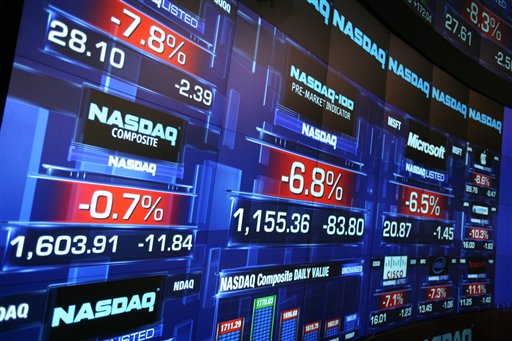
Wall Street joined world stock markets in a sharp selloff
Friday, with the Dow Jones industrials dropping nearly 300 points
in early trading and all the major indexes falling more than 4
percent. The growing belief that the world will suffer a punishing
economic recession has investors dumping stocks.
Wall Street joined world stock markets in a sharp selloff Friday, with the Dow Jones industrials dropping nearly 300 points in early trading and all the major indexes falling more than 4 percent. The growing belief that the world will suffer a punishing economic recession has investors dumping stocks.
The pullback in the U.S. wasn’t as steep as some on Wall Street had feared given the massive declines seen overseas after another round of grim news about the world’s economy and after selling in index futures before the market opened was so intense that trading halts were imposed. In Japan, shares of Sony sank more than 14 percent after it slashed its earnings forecast for the fiscal year. In Germany, Daimler’s stock dropped 11.4 percent after it reported lower third-quarter earnings and abandoned its 2008 profit and revenue guidance.
Japan’s Nikkei stock average fell a staggering 9.60 percent. In Europe, Germany’s benchmark DAX index was down 7.1 percent, France’s CAC40 dropped 5.7 percent while Britain’s FTSE 100 sank 6.8 percent after the government said its gross domestic product fell 0.5 percent in the third quarter, putting the country on the brink of recession.
The dour outlook convinced investors that the world economy is headed for a severe downturn despite a raft of government rescue efforts aimed at pulling the financial system from the brink. It also indicated that the tremors caused by the global credit crisis may have only begun to be felt in their true scope and magnitude.
“There’s a lot of panic out there today,” said Scott Fullman, director of derivatives investment strategy for WJB Capital Group in New York. “People have been saying that we’re in a recession. This is the realization.”
Fearing more carnage in world equity markets, big hedge funds and other institutional investors have been pulling out their money en masse in a bid to reduce risk and raise cash – a process known as deleveraging that only intensifies the selling. Meanwhile, individual investors that have seen their holdings decimated in recent weeks have been yanking money out of mutual funds, adding to the downward pressure on markets.
“I think it would be natural to make an assumption that there are some funds in trouble and that we may see some funds shut down,” Fullman said.
Investors appeared briefly comforted after a real estate trade group said sales of existing homes rose by the largest amount in more than five years in September. The National Association of Realtors said Friday that sales of existing homes rose by 5.5 percent in September compared to August, the biggest jump since a 5.6 percent increase in July 2003. Prices continued to fall, however. The median sales price has dropped to $191,600, down by 9 percent from a year ago.
But that report was overwhelmed by the market’s increasing anxiety.
In late morning trading, the Dow fell 293.34, or 3.38 percent, to 8,397.91 after falling 500 soon after the opening bell. Still, the blue chips remained above the 8,000 level; at its recent low of Oct. 10, the Dow traded as low as 7,882.51. The Dow hasn’t closed below that level since March 31, 2003, when it ended at 7,992.13.
Broader stock indicators also tumbled. The S&P 500 index fell 30.93, or 3.41 percent, to 877.18, and the Nasdaq composite index fell 40.72, or 2.54 percent, to 1,563.19.
The Russell 2000 index of smaller companies fell 13.79, or 2.81 percent, to 476.13.
On the New York Stock Exchange, 244 issues advanced while 2,700 declined. Volume came to 416.6 million shares.
“There’s nothing new going on,” said Scott Bleier, president of market advisory service CreateCapital.com. “This is all about the unwinding of massive leverage.”
Bleier attributed the decline to margin calls and investors in hedge funds and mutual funds cashing out. A margin call occurs when a broker tells an investor to deposit more money into his account because the securities he bought with borrowed money fell to a certain point. When that happens, the investor usually has to sell something else, like stock, to get cash.
“Market participants’ fear is not that the economy is slowing,” he said. “The fear is there is an endless supply of things for sale, regardless of price.”
Meanwhile, demand for U.S. Treasurys remained high as investors sought safe places to put their money. The three-month bill, regarded as the safest asset around, rose to 0.95 percent from 0.94 percent late Thursday.
There were signs that credit markets continue to thaw but are doing so more slowly amid growing economic fears. The rate on three-month loans in dollars – known as the London Interbank Offered Rate, or Libor – fell to 3.52 percent from 3.54 percent on Thursday.
The rates have fallen steadily for 10 days as confidence in the banking industry has been helped somewhat by government rescue measures. However, the improvements were smaller Friday on widening concerns about the health of the global economy.
The yield on the benchmark 10-year Treasury note, which moves opposite its price, fell to 3.64 from 3.66 percent late Thursday.
The U.S. dollar, meanwhile, plunged to a 13-year low, as traders reacted to dismal U.S. jobs data that spurred speculation the Federal Reserve might again cut interest rates. Policymakers are scheduled to announced a decision on interest rates from a scheduled meeting on Wednesday. Meanwhile, gold prices plunged as low as $681 an ounce, the lowest trading level since Jan. 11, 2007.
Light, sweet crude fell $3.30 to $64.54 on the New York Mercantile Exchange. The sell-off, another sign that investors fear a severe recession, came despite OPEC’s announcement that it will cut production by 1.5 million barrels a day in a bid to shore up sagging prices.
Investors had been bracing for a rocky start on Wall Street after futures contracts for the Dow and the S&P 500 fell so low they triggered “circuit breakers,” which froze selling until the market’s 9:30 a.m. EDT open. That slide raised the possibility that circuit breakers intended to prevent panic selling could be triggered during the regular session – something that hasn’t happened since 1997.
The thresholds that would trigger a halt in trading are set at a decline of 10 percent, 20 percent and 30 percent in the Dow, based on where that index was at the beginning of the current quarter; that would mean declines of 1,100 points, 2,200 points and 3,300 points, respectively.
The final hour of trading remains a crucial period as well, with many inventors trying to square away their positions at the last minute. In the past few weeks, some of the market’s worst volatility has come in the last 30 minutes of the session.
Gary Townsend, president and CEO of Hill-Townsend Capital Inc., said a halt in trading was a possibility.
“It’s a way of smoothing market activity and making it orderly. No one would like to see it,” he said.
Elsewhere in Asia on Friday, Hong Kong’s Hang Seng index fell 8.3 percent. Markets in India, Thailand, Indonesia and the Philippines were also down sharply as investors bailed from emerging markets to cut their exposure to risky assets and meet redemption needs at home.
The deepening gloom over growth expectations is having the added effect of putting small economies and currencies under extreme pressure. Investors are pulling money out of countries in Eastern Europe, Latin America and Asia on fears vulnerable countries will not only be hit hard by the financial crisis but may also default on debt.
In Europe, for example, Iceland, Hungary, Ukraine and Belarus are all in talks with the IMF to discuss possible loans.







